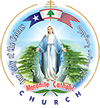The Maronite Catholic Church...
is an Eastern Catholic Church in the West Syriac Antiochene Tradition, a tradition as ancient as Christianity itself.
Maronites have remained loyal to the Catholic faith since their inception in the Fourth Century, and have never broken communication with the Pope and the Church of Rome. Certain Prayers in the Maronite Catholic Liturgy are said in Aramaic, the language spoken by Jesus Christ.
The Maronite Church takes its name from St. Maron, a Syrian herimt who lived in the fourth century. During the Council of Chalcedon in 451 the Syriac Church, along with the Alexandrian (Coptic) and Armenian Churches disagreed with the decision of the Council of Fathers and broke the union with the Great Church. Those who refused to follow the Syriac Church into heresy and remained loyal to the Catholic faith became known as the "Maronites".
The Maronites are one of 22 autonomous, or self-governing churches, which form the Catholic Church. While remaining in communication with the Pope, each Catholic Church has its own hierarhcy and clergy, generally headed by a patriarch or metropolitan, and separate ecclesiastical jurisdictions, called eparchies (dioceses) headed by an eparch (bishop). There are over 20 million Christians worldwide who live out their faith as Eastern Catholics.
Maronite History
Maronites are a people of authentic identity.
The Holy Valley of Kadisha, with its hermitages graved in rocks overhung by the Cedars which endlessly extend the vertiginous summits of the mountains, are the symbols of the Maronites’ tenacity, vitality and independence. The Patriarchal Monastery of Qannoubin, perched as an eagle’s nest, summarizes their entire history”
The term “Maronites” refers to disciples of Saint Maron, a hermit who lived between the fourth and the fifth centuries A. D. in a region near Antioch. Fascinated by his unwavering faith and his profound holiness, devotees from various parts of the region gathered around Saint Maron who lived a life of asceticism and devoted his existence to the love of God. Saint Maron is the patron Saint of the Maronite Church which is the only Catholic Church to hold the name of its founder. Maronites followers are renowned for their strong commitment to the precepts of the Church and are in perfect harmony with the Holy See.
The Maronites lived at a crossroad of different cultures and beliefs and thus, their history was marked by continuous and numerous constraints which lead to persecutions and devastating wars. As early as the year 450 A.D., some disciples of Saint Maron left the North of Syria to take refuge in the Lebanese mountains where they enjoyed peacefulness and security under the shadow of the cedars. It was the undertaking of those disciples and followers of Saint Maron to preach Christianity among inhabitants of these mountains.
Noteworthy that the inhabitants of the Lebanese coastal cities and the Bekaa were the first to embrace Christianity around the year 34 A.D. If we refer to the four Evangelists, the Christ addressed to Lebanese when He visited Tyre, Sidon and their surroundings, which are regions that witnessed some of His miracles. However, villages and inside mountainous regions remained the refuge of pagan followers of God Baal. Though the difficulties Saint Maron disciples encountered in spreading Christianity, they accomplished this daring mission and achieved their goal successfully.
Since then, the history of Maronites has been intertwined with that of Lebanon. Without Maronites, Lebanon would have not existed as an entity, and without Lebanon, Christianity in the Middle East would not have been what it is today. Lebanon remains undoubtedly the only spiritual Land of Maronites who preserve today, as strongly as ever, their tradition of hospitality, openness, attachment to their Land, thirst for freedom, and resolutely unite around their Patriarch.

